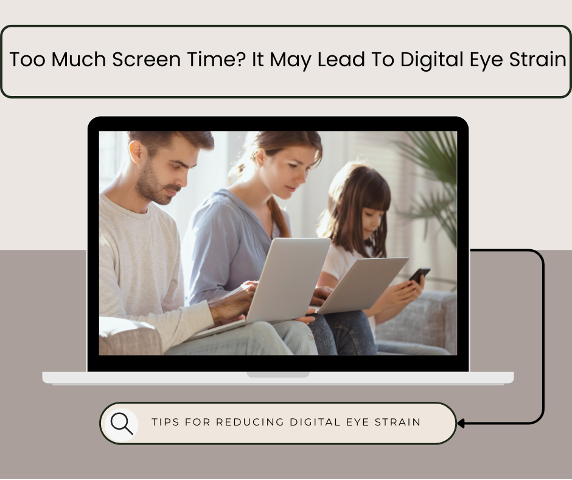Home » Blog » Too Much Screen Time? It May Lead To Digital Eye Strain.
Too Much Screen Time? It May Lead To Digital Eye Strain.
Posted by: Coastal Eye Associates in Eye Health on September 11

Before the age of tablets and smartphones, have you ever wondered how we navigate our daily lives? These electronic devices, from laptops to smartphones, have become a vital part of our work, leisure, and entertainment. A study by Deloitte revealed that Americans check their smartphones more than 8 billion times a day. This habit isn’t limited to a specific age group, as people of all ages check their phones an average of 46 times daily. With Americans spending around five hours each day on browsing the web, social media, and using apps, the total screen time—including work-related computer use—is certainly affecting our eye health.
As our use of digital devices increases, exposing us to blue light and leading more people to develop digital eye strain, it’s useful to understand what science tells us about safe digital screen exposure. Here, we share valuable insights from the respected American Academy of Ophthalmology, a trusted source, about the effects of blue light and its potential harm to your eyes. With their expertise, we aim to provide you with reliable information to help you understand and manage the impact of digital devices on your eye health.
What Is Blue Light?
Color isn’t usually associated with light, but you see the visible light spectrum when looking at a rainbow. The colors visible to the human eye include red, blue, and green “wavelengths.” All light we see combines these wavelengths, including sunlight and light from computer screens.
Blue Light and Sleep
Exposure to blue light from the sun and our digital screens boosts mood and alertness, like sunrise signals to our brain that it’s time to wake up. Still, too much exposure to blue light from screens in the evening can disrupt our body’s natural sleep-wake cycle, known as the circadian rhythm. Light slows the production of melatonin, the sleep hormone in our bodies. Here are a few tips for more restful sleep:
- In the evening, set your digital devices to a night or dark mode. This setting lowers screen brightness, and its warm colors are less likely to confuse your body into thinking it’s daytime.
- Avoid using screens one to two hours before going to sleep.
Too Much Screen Time? It Can Cause Digital Eye Strain.
Staring at digital devices for extended periods can cause temporary discomfort. Everyone experiences eye strain differently, but symptoms may include:
- dry eyes
- blurry vision
- watery eyes
- headache
Many people experience digital eye strain because they blink less often when looking at their screens. The normal blink rate for humans is 15-20 times per minute, but it drops in half when focusing on digital devices. To help prevent digital eye strain, follow these simple tips.:
- Take frequent breaks by using the “20-20-20” rule. Every 20 minutes, look away from your screen and look at an object 20 feet away for at least 20 seconds. Breaks from your screen allow your eyes to reset and replenish themselves.
- Use artificial tears to lubricate your eyes when they feel dry.
- Keep your distance. Sit about arm’s length from your screen and adjust its height so you look slightly downward at it.
- Reduce glare and brightness. To reduce glare, consider a matte screen filter for your device. Adjusting the brightness and contrast of your screen, as well as dimming the lighting near your screen, can also help reduce eye strain.
Your Eye Doctor Can Help!
We’re here to support you, answer any questions, and recommend specific treatments to relieve any discomfort related to your eye health. You don’t have to suffer through symptoms silently; contact us today to schedule an appointment.
Our Top Priority Is Your Eye Health!

